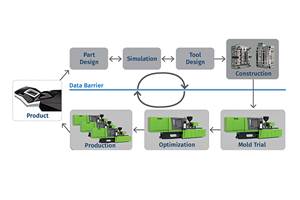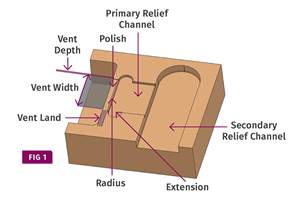Create a Maintenance Work (Bench) Cell
Get better results by improving the organization of your mold-maintenance operation.
By definition, a work cell is an arrangement of resources in a manufacturing environment to improve the quality, speed, and cost of a process by examining the process flow and eliminating waste. The typical lean process focuses on optimizing the end-to-end process as a whole.
While many departments in a plastics processing operation may be a potential work-cell candidate, the mold maintenance area is normally not high on this list. Going lean in a repair environment usually means management reduces head count and then hopes or expects those remaining will just “man-up” and handle the additional work. This strategy, practiced extensively during the economic meltdown of the past couple years, has cost some companies as much as half their repair staff.
The common first reaction of a toolroom supervisor to a lean maintenance mandate is to immediately enact the historical strategy of reducing—and in some case eliminating—scheduled mold preventive-maintenance (PM) checks, if there were any in the first place.
Step 2 is then to shortcut daily mold cleanings, and do only enough critical lubing and firefighting to keep the molds in the presses—consequences be damned. Shortcutting any mold-maintenance tasks does not usually produce sustainable results.
Before someone arbitrarily reduces or eliminates any of the above procedures, or if you are already a victim of it, take a look at reducing the steps and time necessary to perform the PMs and cleanings. You’ll be surprised at how often a repair technician must step away from his bench in order to retrieve the correct tool or perform a specific task.
As noted in past articles, improving repair shop efficiencies involves standardizing maintenance practices while providing repair technicians with the tools necessary to perform specific repair procedures at the proper time. Wasted time looking for and managing “community” tools can be eliminated by equipping your shop benches around the sequence of what happens during specific stages of a typical mold repair. Cost won’t be the issue in adopting bench cell methodology, as much as the determination to make the time to do it. You already have the tools—they just need better organized.
BENCH CELL COMPONENTS
For the most part, workbench size and related tools will be dictated by the type, size, and number of molds you work on. Our work cells at Tooling Docs are designed for hot-runner and multicavity molds with lots of tooling and plates weighing around 6000 lb or less. So the related components are:
•12-ft-long bench, 34-in. high, with 3/8-in.-thick, cold-rolled steel top;
•Electrical power and relevant outlets (120, 220V);
•Two air lines (120 psi) per bench and two to four extra connectors;
•Complete water manifold system with leak and flow restriction line testing;
•Various sizes of eyebolts;
•Small C-clamps (4 to 6 in. ) for plate support;
•Larger bar clamps (1 to 4 ft) for closing molds;
•Plate-support “feet” or angles;
•5-lb rawhide mallet;
•Lifting chains of various lengths;
•Several spray cans of mold cleaners, rust preventers, bolt busters;
•Organized bins for spare SHCS, water fittings;
•Rag or shop towels.
As a jet mechanic in the Navy, our work areas, though not yet designated as “cells,” were set up according to the task being performed on them. The right tools were placed in convenient locations on the bench, which, in turn, physically structured our approach and naturally created good work habits. Such habits include cleaning up your tools, making sure they are working properly, and putting them back where they belong for the next time. When we had to fix a jet quickly and get it back into the air, we could really move. Organized tools make even more sense when working under duress.
In most mold-repair shops, community tools are hung on a board or stored in a (hopefully) central position in the repair shop for all to use and maintain. There are several problems with this method:
•It can be a long walk for those on the back benches to carry multiple heavy tools—so you grab a cart and “hoard” everything you might need for the day.
•The board is not visible from your bench position—so you have to walk there just to discover the tool is missing.
•When it’s not there, you are advised to “look on Bob’s bench.”
•There it is…covered in grease, and bent.
•Things just keep going missing.
Even in a shop where the repair techs have the professional discipline to maintain a community tool center, they still have to walk to it—several times a day.
THINK IT THROUGH
Common tools like eyebolts, clamps, cleaning supplies, chains, large hammers, etc. are better stored and maintained when each bench cell has its own and they are monitored by the one or two guys typically working at these benches. The tools used most often—for assembly and disassembly—should be mounted within easiest reach.
These bench-mounted “shadow boards” might seem a luxury to some, but if you have ever worked in a shop that was so appointed, you know how sweet it is. Cost per table is cheap ($100 for wood and dowel pegs for our 2 x 6 ft table) and most shops usually have enough tools on the community board to divide evenly per table.
Designing a bench as a work cell, outfitted with the noted tools and storage system, will not only make your shop more efficient to work in, but will promote organization, cleanliness, speed, accuracy, and craftsmanship. It will also go a long way to boost morale among repair techs by eliminating the frustration and anxiety experienced when important tools need to be hunted down.
Related Content
Injection Molding Simulation Meets the Real World
Direct data interface between molding simulation and the injection machine links the computer model to the real-world process. This can improve results from product and mold design through ongoing production. A case study demonstrates these benefits for automotive components in a family mold.
Read MoreBack to Basics on Mold Venting (Part 2: Shape, Dimensions, Details)
Here’s how to get the most out of your stationary mold vents.
Read MoreHow to Optimize Pack & Hold Times for Hot-Runner & Valve-Gated Molds
Applying a scientific method to what is typically a trial-and-error process. Part 2 of 2.
Read MoreHow to Mount an Injection Mold
Five industry pros with more than 200 years of combined molding experience provide step-by-step best practices on mounting a mold in a horizontal injection molding machine.
Read MoreRead Next
Why (and What) You Need to Dry
Other than polyolefins, almost every other polymer exhibits some level of polarity and therefore can absorb a certain amount of moisture from the atmosphere. Here’s a look at some of these materials, and what needs to be done to dry them.
Read MoreHow Polymer Melts in Single-Screw Extruders
Understanding how polymer melts in a single-screw extruder could help you optimize your screw design to eliminate defect-causing solid polymer fragments.
Read More









